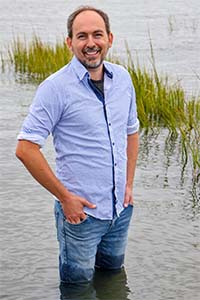
David Samuel Johnson
Associate Professor
Email:
[[dsjohnson]]
Phone:
(804) 684-7513
Office:
Andrews Hall 336
Section:
Ecosystem Health
Lab Website:
{{http://jlabresearch.wixsite.com/jlab}}
Blog:
{{http://www.manayunkia.com/}}
Opportunities in my Lab:
{{http://jlabresearch.wixsite.com/jlab/opportunities}}
I am a marine ecologist. My primary research goal is to understand how global change affects marine animals and their habitats. Primarily, I focus on bottom-dwelling invertebrates. Some people study fish, I study fish food. From polychaetes the size of rice grains that feed on phytoplankton to charismatic fiddler crabs that wave oversized claws and pick algae from the ground, these animals are important links to food webs, biodiversity and ecosystem processes such as carbon storage and primary production.
Education
- B.S. Environmental Science with Honor, University of Central Arkansas, 2003
- Ph.D. Biological Sciences, Louisiana State University, 2008
- Post-doc: Ecosystems Center, Marine Biological Laboratory; Supervisor: Linda Deegan
Science Communcation
Science communication, beyond publishing in peer-reviewed journals, is a critical component of my science. Much of my communication has been via newspaper articles and essays. Some of this stems from my being fascinated with the natural world and wanting to share those experiences with others. It also stems from my desire to take science from the dusty e-files of arcane journals and make that information available to a broader audience. In that vein, you can follow my blog and follow me on Twitter @DavidSamJohnson.Publications
Johnson, D.S. 2015. The savory swimmer swims north: A northern range extension for the blue crab, Callinectes sapdius? Journal of Crustacean Biology
Johnson, D.S. 2014. Fiddler on the Roof: A northern range extension for the marsh fiddler crab Uca pugnax. Journal of Crustacean Biology 34:671-673.
Johnson, D.S. 2014. Making waves about spreading weeds – A response. Science 344:1236
Johnson, D.S. 2014. Weeds making waves. Essay. Science 344:255
Johnson, D.S. and M. I. Short. 2013. Chronic nutrient enrichment increases the density and biomass of the eastern mudsnail, Nassarius obsoletus. Estuaries and Coasts 36: 28-35
Pascal, P-Y, J.W. Fleeger, H.T.S. Boshker, H. Mitwally, and D.S. Johnson. 2013. Chronic nutrient-enrichment influence on mudflat food web in a New England (USA) estuary. Marine Ecology Progress Series. 474:27-41
Fagherazzi S., D.M. FitzGerald D.M., R.W Fulweiler, Z. Hughes, P.L. Wiberg, K.J. McGlathery, J.T. Morris, T.J. Tolhurst, L.A. Deegan, and D.S. Johnson. 2013. Ecogeomorphology of Salt Marshes. In: John F. Shroder (ed.) Treatise on Geomorphology, Volume 12: 180-200.
Fagherazzi S., D.M. FitzGerald D.M., R.W Fulweiler, Z. Hughes, P.L. Wiberg, K.J. McGlathery, J.T. Morris, T.J. Tolhurst, L.A. Deegan, and D.S. Johnson. 2013. Ecogeomorphology of Tidal Flats. In: John F. Shroder (ed.) Treatise on Geomorphology, Volume 12: 201-220.
Deegan, L.A., D.S. Johnson, R.S. Warren, B.J. Peterson, J.W. Fleeger, S. Fagherazzi, and W. Wollheim. 2012. Coastal nutrient enrichment as a driver of salt marsh loss. Nature 490: 388-392.
-Recommended as a ‘must read’ in the Faculty of 1000
-Featured in many popular press outlets including NPR, Boston Globe (DSJ quotation), Cape Cod Times (DSJ quotation), and CBC
Galván, K., J.W. Fleeger, B.J. Peterson, D. Drake, L.A. Deegan, and D.S. Johnson.
2011. Natural abundance stable isotopes and dual isotope tracer additions help to resolve resources supporting a saltmarsh food web. Journal of Experimental Marine Biology and Ecology 410: 1-11.
Johnson, D.S. 2011. High-marsh invertebrate communities are susceptible to eutrophication. Marine Ecology Progress Series 438:143-152.
Fleeger, J.W., D.S. Johnson, K.R. Carman, P.B. Weisenhorn, A. Gabriele, D. Thistle, and J.P. Barry. 2010. The response of nematodes to deep-sea CO2 sequestration: A quantile regression approach. Deep Sea Research I 57:696-707.
Johnson, D.S., and J.W. Fleeger. 2009. The effect of large-scale nutrient enrichment and predator reduction on macroinfauna in a Massachusetts salt marsh: a four-year study. Journal of Experimental Marine Biology and Ecology 373: 35-44.
Johnson, D.S., J.W. Fleeger, and L.A. Deegan. 2009. Large-scale manipulations reveal top-down and bottom-up controls interact to alter habitat utilization by saltmarsh fauna. Marine Ecology Progress Series 377: 33-41.
Johnson, D.S., and B. J. Jessen. 2008. Do spur-throated grasshoppers, Melanoplus spp. (Orthoptera: Acrididae), exert top-down control on smooth cordgrass Spartina alterniflora in northern New England? Estuaries and Coasts 31:912-919.
Fleeger, J.W., D.S. Johnson, K. A. Galván, and L. A. Deegan. 2008. Top-down and bottom-up control of infauna varies across the saltmarsh landscape. Journal of Experimental Marine Biology and Ecology 357: 20-34.
Deegan, L.A., J.L. Bowen, D. Drake, J.W. Fleeger, C.T. Friedrichs, K.A. Galván, J.E. Hobbie, C. Hopkinson, J.M. Johnson, D.S. Johnson, L.E. Lemay, E. Miller, B.J. Peterson, C. Picard, S. Sheldon, J. Vallino, R.S. Warren. 2007. Susceptibility of salt marshes to nutrient enrichment and predator removal. Ecological Applications 17(5):S42-S63.
Johnson, D.S., J.W. Fleeger, K.A. Galván, and E.B. Moser. 2007. Worm holes and their space-time continuum: Spatial and temporal variability of macroinfaunal annelids in a northern New England salt marsh. Estuaries and Coasts 30 (2): 226-237.

